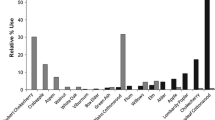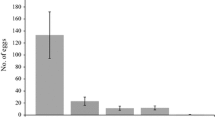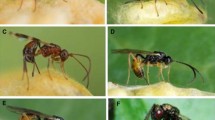Summary
Three hemipteran herbivores partition a common resource plant, Senecio smallii, on the basis of bud density and plant patch size. The monophagous herbivore, Neacoryphus bicrucis, is most abundant in larger patches where bud density is greatest. The oligophagous herbivore, Harmostes reflexulus, is most abundant in small patches of high bud density. The polyphagous species, Lygus pratensis, is most abundant in small patches where abundance is independent of bud density. The aggressive nature of the monophagous herbivore appears to mediate the responses of the other species.
Similar content being viewed by others
References
Alcock J, Eickwort GC, Eickwort KR (1977) The reproductive behavior of Anthidium maculosum (Hymenoptera: Megachilidae) and the evoultionary significance of multiple copulations by females. Behav Ecol Sociobiol 2:385–396
Awasthi AB, Tiwari YC (1975) Studies on the mating behavior of Lygaeus militaris Fabr (Heteroptera: Lygaeidae) Zool Beitr 21:493–499
Benke AC (1978) Interactions among coexisting predators—a field experiment with dragonfly larvae. J Anim Ecol 47:335–350
Benson WW (1978) Resource partitioning in passion-vine butterflies. Evolution 32:493–518
Blakely NR, Dingle H (1978) Competition: Butterflies eliminate milk-weed bugs from a caribbean island. Oecologia (Berl) 37:133–136
Cole LC (1949) The measurement of interspecific association. Ecology 30:411–424
Cromartie WJ Jr (1975) The effect of stand size and vegetational background on the colonization of cruciferous plants by herbivorous insects. J Appl Ecol 12:517–533
Dethier VG (1959) Food plant distribution and density and larval dispersal as factors affecting insect populations. Can Entomol 91:581–596
Hicks KL, Tahvanainen JO (1974) Niche differentiation by crucifer feeding flea beetles (Coleoptera: Chrysomelidae). Am Natur 91:406–423
Hubbell SP, Johnson LK (1977) Competition and nest spacing in a tropical stingless bee community. Ecology 58:949–963
Inouye DW (1978) Resource partitioning in bumblebees: Experimental studies of foraging behavior. Ecology 59:949–963
McCauley DE, Wade MJ (1978) Female choice and the mating structure of a natural population of the soldier beetle, Chauliognathus pennsylvanicus. Evolution 32:771–775
McLain DK (1981) Numerical responses of Muragntia histrionica to concentrations of its host plant. J Ga Entomol Soc 16:(in press)
Myers JP, Connors PG, Pitelka FA (1979) Territory size in wintering sanderlings: the effects of prey abundance and intruder density. Auk 96:551–561
Ralph CP (1977) Effects of host plant density on populations of a specialized seed-sucking bug, Oncopeltus fasciatus. Ecology 58:799–809
Rathcke BJ (1976) Competition and coexistence in a guild of herbivorous insects. Ecology 57:76–87
Root RB (1973) Organization of a plant arthropod association in simple and diverse habitats: the fuana of collards (Brassica oleracea). Ecol Monogr 43:94–124
Root RB, Chaplin SJ (1976) The lifestyles of tropical milkweed bugs, Oncopeltus (Hemiptera: Lygaeidae) utilizing the same hosts. Ecology 57:132–140
Seastedt TR, MacLean SF (1979) Territory size and composition in relation to resource abundance in Lapland longspurs breeding in arctic Alaska. Auk 96:131–142
Seifert RP, Seifert FH (1979) A Heliconia insect community in a Venezuelan cloud forest. Ecology 60:462–467
Shure DJ (1973) Radionuclide tracer analysis of trophic relationships in an old field ecosystem. Ecol Monogr 43:1–19
Solbreck C (1978) Migration, diapause, and direct development as alternative life histories in a seed bug, Neacoryphus bicrucis. In: Dingle H (ed) The Evolution of Insect Migration and Diapause Springer Berlin Heidelberg New York
Strong DR Jr (1977) Insect species richness: Hispine beetles on Heliconia latispatha. Ecology 58:573–582
Vepsalainen K (1978) Coexistence of two competing corixid species (Heteroptera) in an archipelago of temporary rock pools. Oecologia 37:177–182
Verner J (1977) On the adaptive significance of territoriality. Am Natur 111:769–775
White J (1980) Resource partitioning by ovipositing cicadas. Am Natur 115:1–28
Author information
Authors and Affiliations
Rights and permissions
About this article
Cite this article
McLain, D.K. Resource partitioning by three species of hemipteran herbivores on the basis of host plant density. Oecologia 48, 414–417 (1981). https://doi.org/10.1007/BF00346503
Received:
Issue Date:
DOI: https://doi.org/10.1007/BF00346503




